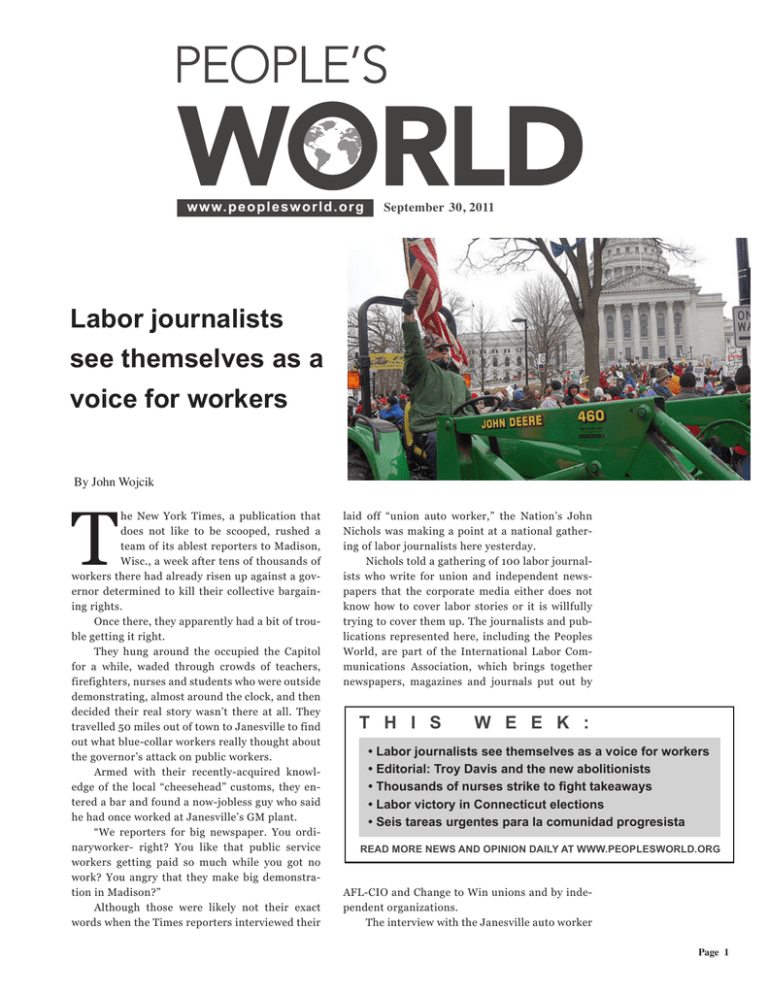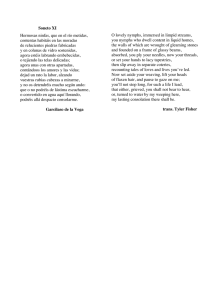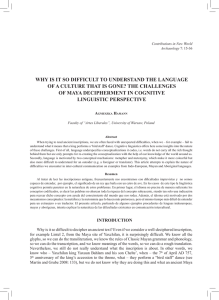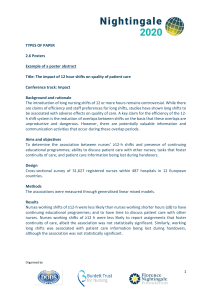Labor journalists see themselves as a voice for
Anuncio

www.pe oplesworl d . o r g September 30, 2011 98 Labor journalists see themselves as a voice for workers By John Wojcik T he New York Times, a publication that does not like to be scooped, rushed a team of its ablest reporters to Madison, Wisc., a week after tens of thousands of workers there had already risen up against a governor determined to kill their collective bargaining rights. Once there, they apparently had a bit of trouble getting it right. They hung around the occupied the Capitol for a while, waded through crowds of teachers, firefighters, nurses and students who were outside demonstrating, almost around the clock, and then decided their real story wasn’t there at all. They travelled 50 miles out of town to Janesville to find out what blue-collar workers really thought about the governor’s attack on public workers. Armed with their recently-acquired knowledge of the local “cheesehead” customs, they entered a bar and found a now-jobless guy who said he had once worked at Janesville’s GM plant. “We reporters for big newspaper. You ordinaryworker- right? You like that public service workers getting paid so much while you got no work? You angry that they make big demonstration in Madison?” Although those were likely not their exact words when the Times reporters interviewed their laid off “union auto worker,” the Nation’s John Nichols was making a point at a national gathering of labor journalists here yesterday. Nichols told a gathering of 100 labor journalists who write for union and independent newspapers that the corporate media either does not know how to cover labor stories or it is willfully trying to cover them up. The journalists and publications represented here, including the Peoples World, are part of the International Labor Communications Association, which brings together newspapers, magazines and journals put out by t h i s w e e k : • Labor journalists see themselves as a voice for workers • Editorial: Troy Davis and the new abolitionists • Thousands of nurses strike to fight takeaways • Labor victory in Connecticut elections • Seis tareas urgentes para la comunidad progresista read more news and opinion daily at www.peoplesworld.org AFL-CIO and Change to Win unions and by independent organizations. The interview with the Janesville auto worker Page 1 They travelled 50 miles out of town to find out what bluecollar workers really thought about the governor’s attack on public workers. ended up as a front-page story in the New York Times the following day bearing a headline that said blue collar workers in Wisconsin were “angry” about the demonstrations by public workers and their allies. A week later still, there was a tiny correction box on the bottom of page 2 of the Times, saying the story was inaccurate and that there was no record of the guy they interviewed ever having worked at Janesville. The tiny correction was printed by the Times after a complaint by the United Auto Workers. Nichols said the Times could have gotten the story right, had they stayed in Madison where 200 UAW members from Janesville were in the Capitol.In any case, the uprising continued for weeks, with Democratic senators bravely setting up shop outside the state to prevent the Republican governor from passing his measure. Then, with no notice, he rammed through his bill without their presence and with no debate. The New York Times headline that day read something to the effect that the Wisconsin union battle was “over.” A day after the Times declared the battle over, more than 100,000-marched on the capital. They were joined by a huge contingent of farmers who came in driving tractors to support them. “Workers are ready to fight on the economic issues. They get it. They were out there ahead of their leaders and ahead of the corporate media. None of this is too radical for them,” said Barbara Kucera, editor of Workday Minnesota. Jeff Johnson, president of the Washington state labor council said that some of the major media “are so cowed that they bend over backwards, in favor of our opponents, to prove they are ‘objective.’” He drew laughter when he said that even if a right wing politician came out with a statement declaring that the earth is flat. Dave Freiboth, executive secretary-treasurer of the Martin Luther King Jr. County Labor Council and a member of the Inland Boatmens’ Union, told the journalists that they need to take advantage of “one big weakness that the right-wing has.” “They have no alternative to the labor movement when it comes to guaranteeing jobs, wages and fairness. The people can understand this, provided we get out that message.” John Wojcik is labor editor of the People’s World. Troy Davis and the new abolitionists By PW Editorial Board Nearly half the public supports the sentence of life without parole over the death penalty. H undreds held vigil outside death row, hoping, fasting, protesting and praying for a miracle or some modicum of justice for Troy Davis. None came. But in those emotions and in that fight to save Davis’s life, a new abolitionist movement was born. “Troy’s execution, the exceptional unfairness of it, will only hasten the end of the death penalty in the United States,” said NAACP’s Ben Jealous. Whatever the factors, the birth of a new movement to abolish the death penalty has arisen as Georgia carried out this execution. About the death penalty, there are many opinions. The Supreme Court had two: one in 1973 that banned capital punishment as unconstitutional, and later, one in 1976 that allowed it under certain circumstances. Public support for the death penalty had been relatively high since its reinstatement, swinging upwards to more than 80 percent favoring it. Political campaigns laced with racial and tough-on-crime hysteria undoubtedly boosted the numbers. But science and DNA evidence helped put a damper on this. www. p eo p l esw o rld .o r g DNA evidence used to prove the innocence of death row convicts accelerated since 2000. There have been 273 post-conviction exonerations in the U.S., 206 of them since 2000. Seventeen of the 273 wrongly-convicted had been on death row. Since 1973, 138 people have been freed from death row by DNA and other evidence. Polling data indicates nearly half the public supports the sentence of life without parole over the death penalty. Then came the numerous reports and studies that showed blatant racial, class, regional and political bias in the death penalty’s application. Grave questions of guilt or innocence, barbarism or civilization, blunder or repair, injustice or fairness swirl around Georgia’s execution, and they do not go quietly into the night. Neither do the students who rode buses from Spelman and Morehouse colleges to Jackson, Ga. Nor do the human rights activists throughout the South where 80 percent of executions are held. Nor do the millions of people throughout the U.S. aroused by the questions raised and justice denied in this case. Meet the new abolitionists. Page 2 Thousands of California nurses strike to fight takeaways By Marilyn Bechtel N urses picketing Sutter Alta Bates Medical Center in Berkley, Calif., Sept. 22 broke into boisterous cheers as AFLCIO President Richard Trumka asked them, “Is anyone out there fed up with Corporate America?” The nurses were among 23,000 of their coworkers holding a one-day strike at three-dozen Sutter Health and Kaiser Permanente facilities in northern and central California, as well as Oakland Children’s Hospital. Calling nurses “the last line of defense for patients,” Trumka said nurses “have more responsibility in an hour” than executives have “in a year ... Sutter’s here for the profits, you’re here for the patients. Sutter wants to work the system, you want the system to work for everyone.” Trumka pledged that the AFL-CIO’s 12.5 million members “are not just on your side, we’re at your side. We thank you for having the courage and commitment to stand up for patient care and good jobs.” The nurses’ union, the California Nurses Association/National Nurses United, says that despite amassing $3.7 billion in profits over the last five years, Sutter Health is insisting on demands that would limit nurses’ ability to advocate for their patients, end paid sick days, forcing them to work while sick, and slash their health care coverage and retiree health benefits. The nurses are also protesting dozens of cuts in services at Sutter facilities. A handout at the rally listed 20 Sutter executives with salaries of more than $1 million a year - four of them over $2 million. CEO Pat Fry’s pay was listed as nearly $4 million. www. p eo p l esw o rld .o r g Pennie Torres, who said she’d recently been hospitalized at Alta Bates, part of the time on life support, said as she began to recover she’d noticed that nurses and other health care workers were having to work while they themselves were sick. “Don’t let others have to suffer what I did,” she said. Nurses at Children’s Hospital Oakland were protesting inadequate staffing there, as well as management’s efforts to cut their health coverage, which they say would make it prohibitively expensive to bring their own children for care to the hospital where they work. Kaiser nurses were striking in solidarity with other Kaiser workers who face deep cuts in health coverage and retirement benefits. Also on the picket line were hospital workers from other disciplines. But, one said, the hospitals “have once again chosen to squander everyone’s health care dollars” by hiring “replacement workers” for several days beyond that. “They should be ashamed for that,” she said. Nurses at Children’s Hospital Oakland were protesting inadequate staffing there. Page 3 local news L o c a l c o n t a ct [email protected] Labor victory in Conn. elections By Joelle Fishman I n an extraordinary Democratic primary election, New Haven, Conn., voters overwhelmingly backed labor and grassroots community candidates for Board of Aldermen in 14 of 15 wards where contests were held last week. The 30-member body will now have a pro-labor majority, including several unopposed incumbents. Brian Wingate, who defeated Aldermanic president Carl Goldfield by a wide margin, beamed at the joyous celebration party as he called forward all the newly elected. They include Local 34 and 35 service / maintenance and clerical / technical workers at Yale, an SEIU Local 1199 group home worker, an AFSCME children and families worker and several pro-labor community activists. Fueled by anger at 25 youth homicides this year and deep poverty in the midst of great wealth, city residents made it clear that they want their voices heard. Over 400 residents joined the candidates to knock on the doors of their neighbors in the summer months, discuss issues of concern and register voters. The candidates and their family, friends, union sisters and brothers and neighbors including many young people volunteered between four and sixteen hours a week. They comprised a cross section of the multi-racial composition of the city. “At the beginning of the summer many people didn’t think what we were doing would make a difference. There was anger and despair at the killings, the lack of youth opportunities and the lack of jobs. By election day, that had changed to a sense of hope and excitement,” said one canvasser for Delphine Clyburn in the Newhallville neighborhood. The campaign effort was watched nationally, and sets a precedent for local politics and for successful turnout in the 2012 presidential and congressional elections. www.p eo p l esw o rl d .o r g Seis tareas para la comunidad progresista y la izquierda Por Sam Webb D esde que Reagan fue eligido presidente hace más de tres décadas, los extremistas de ultraderecha reunidas bajo la bandera del Partido Republicano han buscado reestructurar el papel y las funcciones del gobierno a beneficio de las capas superiores de la clase capitalista. Una de sus metas principales ha sido la de desmantelar al conjunto de programas y derechos sociales (Seguro Social, Medicare, Medicaid, y derechos laborales, civiles, de la mujer y de gente con descapacidades, los derechos electorales, y mucho más) legislados durante las últimas ocho décadas. Estos logros progrestistas son anátema para ellos. En vez de triunfos, la derecha los ve como tristes episodios en la historia norteamericana. Es así que nadie que se beneficie de alguna manera de estos derechos y de estos programas, y esto quiere decir casi todo norteamericano, debe quedarse confortable. Ya no se consideran como patrimonio de cada norteamericano una red de seguridad social para personas mayores, ni un nivel mínimo de cuidado de salud, ni las garantías más básicas de la igualdad y la democracia. La verdad es que ya queda precario su futuro. Pero, ¿qué se necesita para salvar estos elementos centrales de nuestro compacto social? Lo mismo que hacía falta para ganarlos: una lucha sostenida de masas, por parte de un amplio movimiento multirracial conducido por los trabajadores. Bajo estas circunstancias, juegan un papel esencial la izquierda y la comunidad progresista. Este es lo que podemos y debemos que hacer: 1) Alumbrar los enlaces entre la n a t i o n a l dinámica interna del capitalismo, la crisis económica capitalista, y la embestida actual en contra de los derechos y niveles de vida de la gente. En especial, hay que recordarles a todos que la misma “empresa libre” desreglada que nos ha metido a esta crisis no nos va sacar de ella nunca, y por eso hace falta un gobierno proactivo y al lado del pueblo. 2) Hacer el caso de que nuestra prioridad nacional inmediata y sobresaliente es la de la creación de trabajos. En realidad, en estos momentos las medidas de austeridad resultarían dañinas a la gente trabajadora, a la economía, y a nuestra salud fiscal a largo término. De hecho, minar a estos programas sería como un puñal al corazón de la gente trabajadora, y a la gente de color en especial, y sería exactamente la medicina equivocada para una economía que ya anda coja gracias a la falta de compras por parte del consumidor. 3) Construir una estrategia que se enfoque sobre en obstáculo principal al cambio positivo, que es el extremismo de ultraderecha. 4) Fortalecer la lucha contra el racismo, práctica ideológica y social. 5) Encontrar formas para reunir al más amplio movimiento posible en defensa a estos programas y estos derechos. No nos ayudan las tácticas estrechas que dejan marginados a aliados, aunque sean temporales, contraponen demandas radicales a las más inmediatas, y minimizan al peligro del extremismo ultraderechista. 6) Conectar a todas las luchas contra la derecha a las próximas elecciones nacionales. Hoy más que nunca, hace falta el papel histórico de la izquierda y de la comunidad progresista. Hagámoslo. c o n t a ct Editorial: (773) 446-9920 Business: (212) 924-2523 Email: [email protected] Page 4








